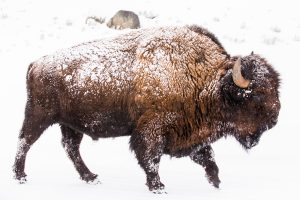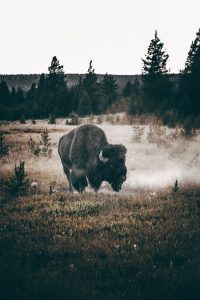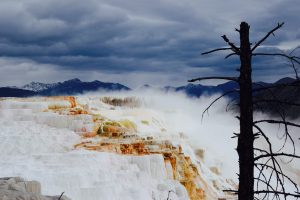
Bison Migration in Yellowstone: Challenges and Solutions
Bison are somber, majestic animals who are often seen making their way across the plains and river valleys of National Parks like Montana’s Yellowstone National Park. Tourists to Yellowstone frequently experience waiting in “traffic” as buffalo herds come to a standstill on roads through the National Park. Bison (also called Buffalo) roam freely as they seek out water and pasture, but this has resulted in conflict when they roam beyond the bounds of the park.
Why is Buffalo Conflict High Stakes?
 Buffalo conflict is high stakes because conflict puts their lives at risk. Buffalo lives are often forfeited as a solution to the conflict. They are large animals who have impacts on the environment and on the human way of life. Up until recently, Park Management’s policy was to cull large numbers of Buffalo who roamed beyond the boundaries of the park. This was partly to discourage Bison mingling with cattle because of the risk of contracting brucellosis. The state of Montana sued the park and enforced the policy of culling Bison. Due to the habits of Bison, this policy has been unsuccessful as well as unnecessarily violent. Bison’s roaming patterns are seasonal and motivated by a response to weather conditions. Much of Yellowstone is snowbound into April. During the long winter months, Bison migrate into more populated areas to circumvent conditions in the park that make movement and grazing difficult.
Buffalo conflict is high stakes because conflict puts their lives at risk. Buffalo lives are often forfeited as a solution to the conflict. They are large animals who have impacts on the environment and on the human way of life. Up until recently, Park Management’s policy was to cull large numbers of Buffalo who roamed beyond the boundaries of the park. This was partly to discourage Bison mingling with cattle because of the risk of contracting brucellosis. The state of Montana sued the park and enforced the policy of culling Bison. Due to the habits of Bison, this policy has been unsuccessful as well as unnecessarily violent. Bison’s roaming patterns are seasonal and motivated by a response to weather conditions. Much of Yellowstone is snowbound into April. During the long winter months, Bison migrate into more populated areas to circumvent conditions in the park that make movement and grazing difficult.
Are Bison Endangered? Can They Roam Freely?
Bison or buffalo herds were almost eradicated during historical programs to reduce wild animals to extinction. They were restored through strenuous conservation efforts. There are currently around 6,000 Bison in Montana. Bison also roam in other areas of the US, mostly in National Parks. Their population numbers are frequently threatened by conflict involving their roaming patterns which bring them into contact with cattle and people.
What Can Be Done to Resolve Conflict Between Bison and Humans?
Bison are wild animals that weigh up to 3,000 pounds and can run at 35 miles per hour. They can be dangerous to people. They also carry brucellosis, a disease that can harm livestock. It’s important to recognize that bison are wild animals, not pets or photo opps for tourists. As such, they should be treated with respect. Humans and other animals should keep their distance.
To facilitate the freedom of Bison but also the safety of humans and other animals, conflict resolution has focused on rebuilding bison populations in Tribal areas and protected National Park areas, and reducing the slaughter of bison in favor of quarantine and re-homing. Various groups have come together to find solutions including conservation authorities and experts, park officials, tribes, animal advocacy groups and communities. As bison populations re-establish, this work will require respectful dialogue. Animal Rights mediation can facilitate these dialogues to bring together diverse perspectives.
Case Study: A Success Story for Bison in Yellowstone National Park
 The work of animal advocacy groups to put pressure on park services, and the innovative response of the park to these efforts has been a success story, but the issues are not over. The Yellowstone park authorities are reducing the number of bison culled in favor of capturing the animals, putting them in quarantine and releasing animals unaffected by disease to their natural habitats and tribal lands. Because culling is still an element of these solutions these conflicts still have very high stakes.
The work of animal advocacy groups to put pressure on park services, and the innovative response of the park to these efforts has been a success story, but the issues are not over. The Yellowstone park authorities are reducing the number of bison culled in favor of capturing the animals, putting them in quarantine and releasing animals unaffected by disease to their natural habitats and tribal lands. Because culling is still an element of these solutions these conflicts still have very high stakes.
Animal conflict is high stakes because very often it puts animal lives at risk. As experienced animal rights mediators, at Boileau Conflict Solutions, we have mediated many conflicts in which animal lives are on the line.
Non-violent solutions are much more accessible than people imagine. Our mediators re-imagine conflict resolution as a negotiation that involves non-human animals and ecosystems as parties to the solution. When animal interests are considered it is often much easier to reach a solution because the solutions work around the science of animal behavior such as the natural patterns of Bison migration. Thus the solutions are long-lasting and do more than apply a band-aid to the problem. Most importantly, many animal lives are saved.
If your dispute involves wild animals, our mediators are available remotely or in person to support the resolution of your conflict. We have offices in Bozeman, MT, San Diego, CA, Silicon Valley, CA and in Michigan. Please contact us to learn more about our animal rights mediation services.
